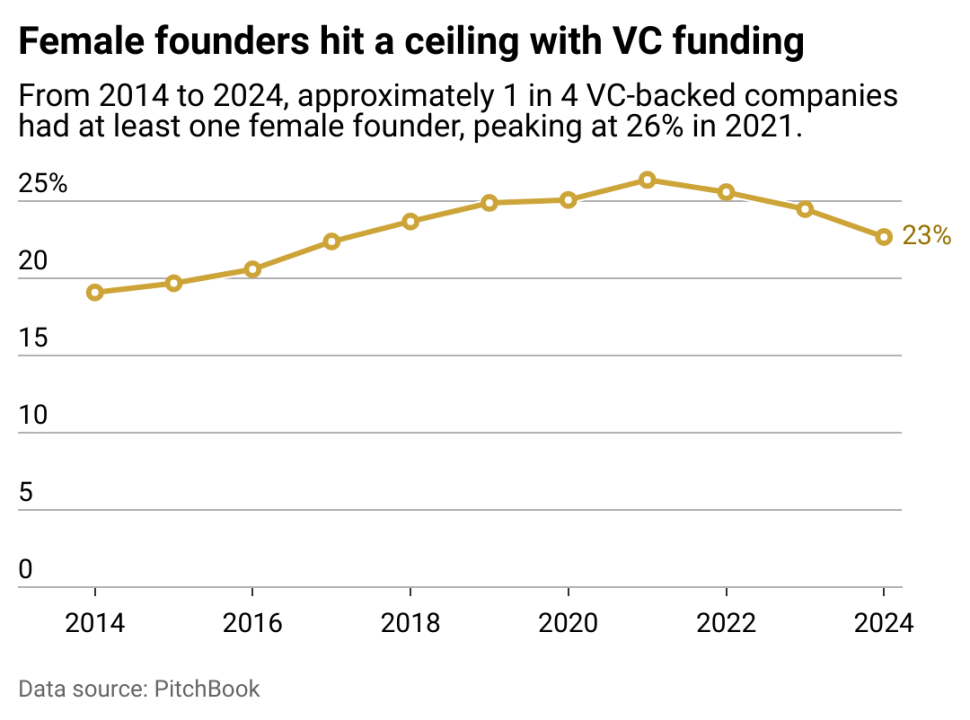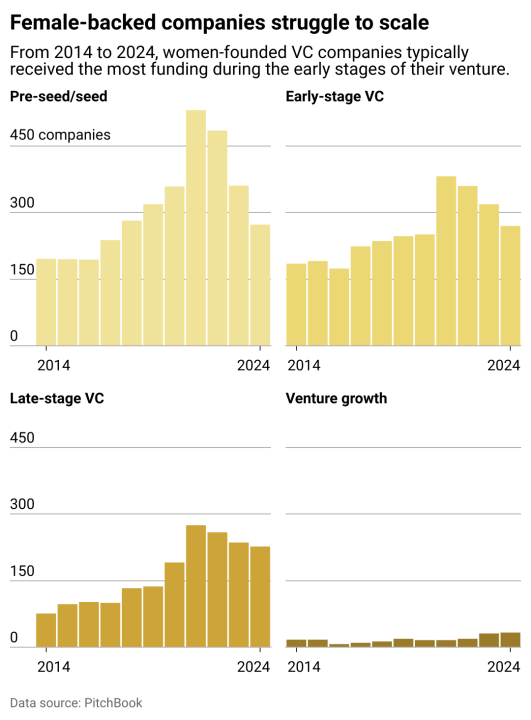Women helm more companies than ever. Why is it still so hard for them to get funding?

Josep Suria // Shutterstock
Women helm more companies than ever. Why is it still so hard for them to get funding?
Though venture funding involves hard numbers—like financials and market data—the process of receiving a check worth millions of dollars is surprisingly less scientific. Venture firms wade through countless emails and elevator pitches. Armed with funding entrusted to them by their partners, venture capitalists must try to diffuse the risk for investors while gaining as much value from the companies as possible.
The result is a rather unregulated system, one that involves networking and intuition. Consequently, the venture ecosystem suffers from the same problems many other industries do: Startups helmed by women receive far less funding than those run by men. According to the Harvard Kennedy School, venture capital is a male-dominated field, allowing unconscious bias to negatively affect women founders.
In 2023, at least 5% of all startups in the United States were founded by women, the Global Entrepreneurship Monitor estimates. Yet they receive only about 1.8% of venture capital funding according to PitchBook data. To discover where the gaps lie, Company Insights examined data from PitchBook’s NVCA quarterly report and explored the gender disparities in startup funding.
PitchBook found that funding for women-led startups has dropped off since reaching a high of $64.5 billion in 2021. While first-time financing for men dipped between 2016 and 2021, the recipients that benefited were largely companies founded by a mix of genders rather than all-women founders.
The situation doesn’t get any better as a business matures. As women-led startups continue to grow and develop, they are less likely to receive late-stage funding when compared with earlier funding stages. Late-stage funding rounds often involve large amounts of capital in the $100 million range and allow companies to scale. In some cases, these companies may even go public on the stock market. While pre-seed and seed rounds are often dedicated to startups in their infancy—companies that don’t have any revenue and are still in their ideation phase—late-stage companies often pull in consistent revenue.
“One of the things that might be why they’re not securing later stage funding is network limitations, meaning that female founders might not know those people that provide the later stage capital,” Melinda Moore, a Los Angeles entrepreneur and limited partner at Coyote Ventures, told Stacker.
Over the years, there has been an increased effort in the venture community to combat this imbalance. From January 2012 until December 2022, Moore co-led Tuesdaynights, a networking event for women entrepreneurs and venture capitalists that allowed both parties to bridge the gender gap. Other venture firms have popped up to specifically fund women founders, like Halogen Ventures, Emmeline Ventures, and digital health-geared Coyote Ventures.

Company Insights
The gender gap in VC funding
While women founders have made significant gains in the last 10 years, funding distribution still hasn’t achieved parity. After 2021, funding toward those startups with at least one woman founder dwindled from 26% to 23%.
When raising their first venture round, the investment stage considered riskiest by investors due to lack of proof of concept or revenue, women also have a harder time than men receiving funding. Between 2014 and 2024, companies founded by only women received just 6.8% of first-time funding. By comparison, companies led by only men that raised their first round took 76.2% of funding during the same period.
There are structural reasons for this disparity—a 2021 PitchBook study found that in the U.S., general partners who manage venture capital funds were 84.6% men, leading to less diversity among venture capitalists who are ultimately in charge of funding allocations. Because of this lack of diversity and the general inclination to invest in businesses that align with one’s experience or interests, there is also an unfounded sentiment that women-owned businesses are riskier investments, which may only merit funding during years of plenty. For example, in 2021, when there were ample budgets, funding to women-led companies was at a 10-year high. As the economy began to suffer and investors tightened their purse strings, funding to those companies fell.
The trends mirror what PitchBook saw in 2020, when, amid uncertainty around the COVID-19 pandemic, women-led companies saw a 28% decline in funding, compared to a 5% decline for men between March and June of that year.
Women-led startups also seem to be held to a higher standard that allows no mistakes to be made. In 2024, researchers from the Yale School of Management, University of Toronto, and Columbia examined data from LinkedIn and PitchBook, found that women get 22% less funding than male founders if a venture firm has had negative experiences with an unrelated woman-led startup in the past.

Company Insights
How much funding do female founders receive?
Even as women-led companies grow out of their first round, depleting capital, they have a difficult time continuing to raise money. Of all funding funneled into companies founded by women between 2014 and 2024, only 22% went to late-stage companies.
According to the researchers, this disparity has little to do with the kinds of companies that are being founded. In the Yale, the University of Toronto, and Columbia study, researchers also explored the outcomes of subsequent efforts by male and female co-founders of the same company. They liken it to “twin studies” but for business. Their research found that compared to their male co-founders, women are 18% less likely to raise VC funding after a successful first venture and 30% less likely after a failed business.
The increasing difficulty of securing VC funding for women founders is perhaps why Moore continues to find other ways to raise funds. “I’m always trying to come up with alternative ways to capital,” Moore said. “Whether that’s working capital, whether it’s debt, whether it’s crowdfunding. Venture capital can’t be the holy grail, right? Because then women are really left out of the equation.”
This has many negative consequences for women-owned startups, the employees that work at them, and the existing investors taking a gamble to fund them. Without being able to cobble together extra capital, these companies cannot plan for the long-term, make their products better, and succeed in the market.
Trends are inching toward parity, however, and companies founded by only women have been starting to see more late-stage funding since 2019. In 2024, 28% of venture capital deals to women-founded companies went toward late-stage financing, a 10-year high. That same year, 34% of funding went toward nascent companies and another 34% went to early-stage companies.

Ground Picture // Shutterstock
Where female entrepreneurs are supported the most
According to a 2024 Wells Fargo report, women-owned businesses overall—not just those in the venture scope—thrive in certain states due to training, counseling, networking efforts, and financing programs. New York, which ranked as the most friendly state to those businesses, gives priority to women-owned companies when it awards state contracts. It also has the highest utilization rate of any state when it comes to minority- and women-owned businesses.
North Carolina has a slew of resources, including training and access to financing, women-owned businesses can tap into. Georgia’s women-owned firms contribute a significant amount to the state economy, ranking #7 in terms of revenue share.
Some states, however, struggle to provide women-owned businesses with funding opportunities, either because of financial constraints or gender discrimination. Others also have few opportunities for women to network or receive training on running or growing a business, which affects how many women-led businesses can thrive in the long term.
Alaska experienced the smallest growth of women-owned companies between 2019 and 2023 of any state. Nebraska fared slightly better with a growth rate of 3.7%—employment at women-owned firms dropped 23.6%. People in these areas could look beyond their borders and consider best practices to adopt since systemic efforts are a linchpin in encouraging women to start businesses.
According to the Global Entrepreneurship Monitor, which has tracked women entrepreneurs globally for 25 years, when governments and stakeholders strongly advocate for women entrepreneurs, these founders adopt positive perceptions of themselves and the opportunities available to them. In its GEM Women’s Report, the authors wrote, “If we can change people’s minds about any fears of starting a business, they will change their own behaviors in ways that can power a nation.”
Story editing by Carren Jao. Copy editing by Kristen Wegrzyn.
This story was produced by
The Data Project and was produced and
distributed in partnership with
Stacker.
![]()



